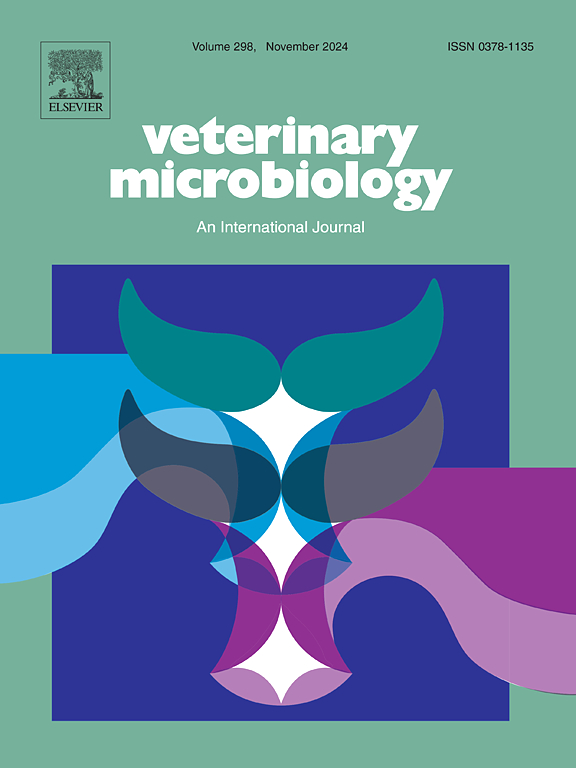FCV通过离子依赖途径激活NLRP3炎性体,促进IL-1β分泌
IF 2.4
2区 农林科学
Q3 MICROBIOLOGY
引用次数: 0
摘要
猫杯状病毒(FCV)在全球流行中对易感动物的健康构成重大威胁。炎症小体在病原体诱导的炎症过程中起着至关重要的作用,在抵抗病原体入侵、响应细胞损伤和维持内部环境稳态方面发挥作用。猫感染FCV引起炎症,NLRP3炎性体对感染细胞炎症因子的调控机制亟待进一步研究。本研究以该炎性小体为切入点,重点研究其激活IL-1β分泌的激活信号。通过细胞实验,分析该炎性小体与细胞内环境、热亡、病毒编码蛋白调控IL-1β分泌的分子机制和逻辑关系。结果表明,fcv感染的细胞诱导NLRP3炎性体的激活和组装,从而激活该信号。fcv诱导的IL-1β分泌依赖于该炎性体的激活。在感染的早期阶段,这种炎性体的激活和IL-1β的分泌依赖于细胞Ca2 +内流和K+外排。fcv编码蛋白p32/LC激活该炎性体并随后诱导IL-1β分泌取决于其介导细胞Ca2+内流和K+外排的功能。总之,本研究表明,在FCV感染细胞后,其p32和LC蛋白以依赖于Ca2+内流和K+外排的方式激活NLRP3炎性体激活信号,诱导IL-1β分泌。此外,fcv诱导的焦亡也会触发IL-1β的分泌。本研究结果从一个新的角度阐明了FCV的致炎机制,为抗炎药物的设计和筛选提供了新的药物靶点。本文章由计算机程序翻译,如有差异,请以英文原文为准。
FCV activates NLRP3 inflammasome through ion-dependent pathway to promote IL-1β secretion
Feline calicivirus (FCV) poses a significant threat to the health of susceptible animals in the global epidemic. The inflammasome plays a crucial role in the inflammatory process induced by pathogens, functioning in resisting their invasion, responding to cellular damage, and maintaining internal environmental homeostasis.FCV infection in cats causes inflammation,and the regulatory mecha-nisms of the NLRP3 inflammasome on inflammatory factors in infected cells urgently require further investigation.This study focuses on this inflammasome as the entry point, focusing on its activation signal that activates IL-1β secretion.Through cellular experiments, it analyzes the molecular mechanisms and logical relationships between this inflammasome, intracellular environ-ment, pyroptosis, the regulation of IL-1β secretion by viral-encoded proteins.The results showed that FCV-infected cells induced the activation and assembly of the NLRP3 inflammasome, thereby activating this signaling. FCV-induced IL-1β secretion was dependent on the activation of this inflammasome. In the early stages of infection, the activation of this inflammasome and IL-1β secretion were dependent on cellular Ca2 + influx and K+ efflux. IL-1β secretion also relied on FCV-induced pyroptosis;The activation of this inflammasome by the FCV-encoded protein p32/LC and the subsequent induction of IL-1β secretion are contingent upon the function of its in mediating cellular Ca2+ influx and K+ efflux.In summary, this study demonstrates that following FCV infection of cells, its p32 and LC proteins activate the NLRP3 inflammasome activation signal in a manner dependent on Ca2+ influx and K+ efflux,Induce IL-1β secretion. In addition, FCV-induced pyroptosis also triggers the secretion of IL-1β. The findings of this study elucidate the leading to inflammatory mechanisms of FCV from a novel perspective, providing new drug targets for the design and screening of anti-inflammatory drugs.
求助全文
通过发布文献求助,成功后即可免费获取论文全文。
去求助
来源期刊

Veterinary microbiology
农林科学-兽医学
CiteScore
5.90
自引率
6.10%
发文量
221
审稿时长
52 days
期刊介绍:
Veterinary Microbiology is concerned with microbial (bacterial, fungal, viral) diseases of domesticated vertebrate animals (livestock, companion animals, fur-bearing animals, game, poultry, fish) that supply food, other useful products or companionship. In addition, Microbial diseases of wild animals living in captivity, or as members of the feral fauna will also be considered if the infections are of interest because of their interrelation with humans (zoonoses) and/or domestic animals. Studies of antimicrobial resistance are also included, provided that the results represent a substantial advance in knowledge. Authors are strongly encouraged to read - prior to submission - the Editorials (''Scope or cope'' and ''Scope or cope II'') published previously in the journal. The Editors reserve the right to suggest submission to another journal for those papers which they feel would be more appropriate for consideration by that journal.
Original research papers of high quality and novelty on aspects of control, host response, molecular biology, pathogenesis, prevention, and treatment of microbial diseases of animals are published. Papers dealing primarily with immunology, epidemiology, molecular biology and antiviral or microbial agents will only be considered if they demonstrate a clear impact on a disease. Papers focusing solely on diagnostic techniques (such as another PCR protocol or ELISA) will not be published - focus should be on a microorganism and not on a particular technique. Papers only reporting microbial sequences, transcriptomics data, or proteomics data will not be considered unless the results represent a substantial advance in knowledge.
Drug trial papers will be considered if they have general application or significance. Papers on the identification of microorganisms will also be considered, but detailed taxonomic studies do not fall within the scope of the journal. Case reports will not be published, unless they have general application or contain novel aspects. Papers of geographically limited interest, which repeat what had been established elsewhere will not be considered. The readership of the journal is global.
 求助内容:
求助内容: 应助结果提醒方式:
应助结果提醒方式:


